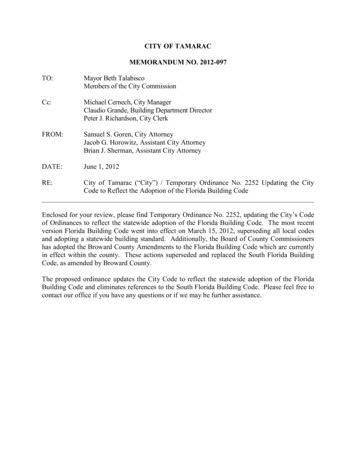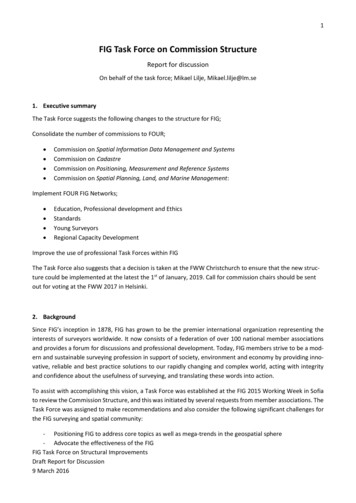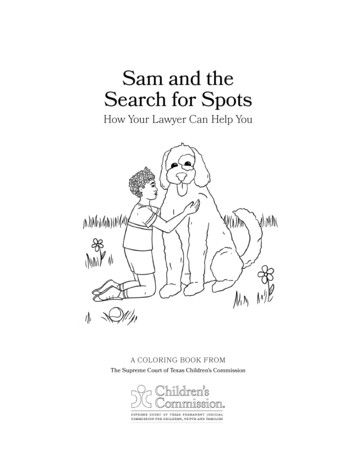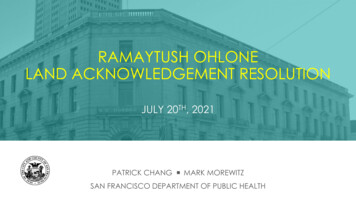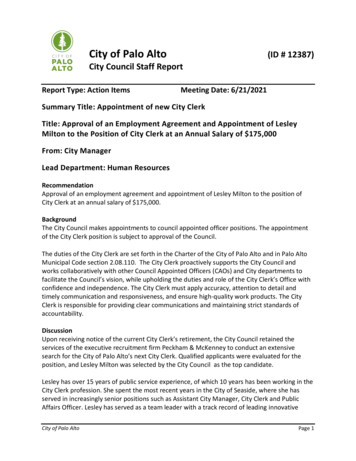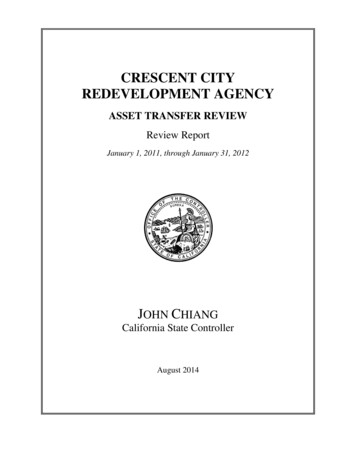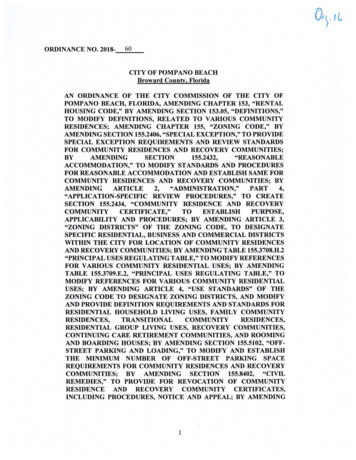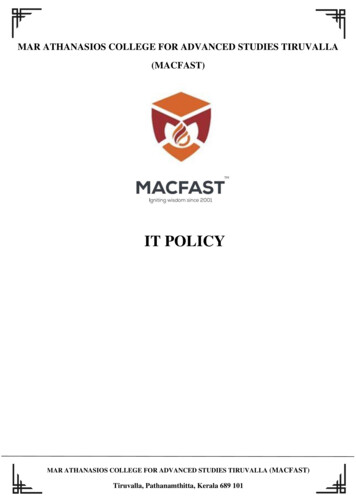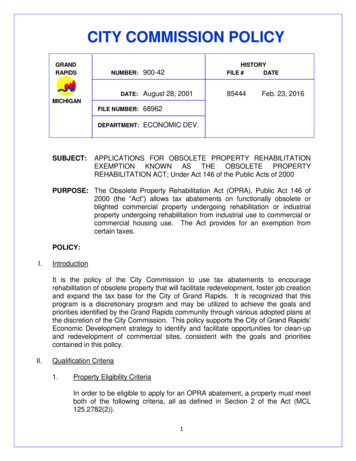
Transcription
CITY COMMISSION POLICYGRANDRAPIDSNUMBER:DATE:900-42HISTORYFILE #DATEAugust 28, 200185444Feb. 23, 2016MICHIGANSUBJECT:FILE NUMBER:68962DEPARTMENT:ECONOMIC DEV.APPLICATIONS FOR OBSOLETE PROPERTY REHABILITATIONEXEMPTION KNOWN AS THE OBSOLETE PROPERTYREHABILITATION ACT; Under Act 146 of the Public Acts of 2000PURPOSE: The Obsolete Property Rehabilitation Act (OPRA), Public Act 146 of2000 (the “Act”) allows tax abatements on functionally obsolete orblighted commercial property undergoing rehabilitation or industrialproperty undergoing rehabilitation from industrial use to commercial orcommercial housing use. The Act provides for an exemption fromcertain taxes.POLICY:I.IntroductionIt is the policy of the City Commission to use tax abatements to encouragerehabilitation of obsolete property that will facilitate redevelopment, foster job creationand expand the tax base for the City of Grand Rapids. It is recognized that thisprogram is a discretionary program and may be utilized to achieve the goals andpriorities identified by the Grand Rapids community through various adopted plans atthe discretion of the City Commission. This policy supports the City of Grand Rapids’Economic Development strategy to identify and facilitate opportunities for clean-upand redevelopment of commercial sites, consistent with the goals and prioritiescontained in this policy.II.Qualification Criteria1.Property Eligibility CriteriaIn order to be eligible to apply for an OPRA abatement, a property must meetboth of the following criteria, all as defined in Section 2 of the Act (MCL125.2782(2)).1
A.B.2.blighted or functionally obsolete, ANDcommercial housing property or commercial propertyApplicant Eligibility CriteriaIn order for the City Commission to consider an application for an OPRAabatement, the applicant (defined as the individual or entity which owns orproposes to own the property) must meet all of the following criteria:A.B.C.D.E.F.3.The applicant must have a legal interest in the property for which anabatement is being sought, or must provide documentationevidencing its ability to acquire the property (i.e. binding purchaseagreement).The applicant represents that the project would not have beenconsidered without the exemption certificate.The applicant must be compliant with the City’s income tax ordinance.The applicant must not be delinquent on any financial obligations to theCity.The applicant must not have any outstanding written orders orviolations for any property under its ownership that is located in theCity.Before an application which has been approved by the CityCommission will be forwarded to the State Tax Commission forapproval, the applicant shall have filed a completed MichiganDepartment of Treasury Form 2766 – Property Transfer Affidavit L4260 with the City Assessor related to its acquisition of the property.The Property Transfer Affidavit shall be considered incomplete if thepurchase price of the real estate is not entered on the form.Project Eligibility CriteriaIn order for the City Commission to consider an application for an OPRAabatement, the proposed project must meet the following criteria:A.B.C.D.E.F.Projects are located within the Community Development Target Areasor within a recognized neighborhood business association boundaryas shown on the attached map.The rehabilitation project was not started prior to the CityCommission’s establishment of the Obsolete Property RehabilitationDistrict.Commercial housing projects must propose a minimum of ten (10)units or be part of a mixed-use redevelopment project.Projects must have a minimal investment of 30 per gross squarefoot (excluding basement levels), excluding acquisition.There are no delinquent taxes on the facility or the structure beingrenovated.All applicants must be in compliance with the zoning ordinance, havereceived the necessary approvals, or propose to come into2
G.H.I.J.compliance with the zoning ordinance as part of the project.All applicants must enter into a Memorandum of Understanding withthe City of Grand Rapids.Environmental Requirement: The City’s Environmental ServicesDepartment will review the history of the property/applicant forenvironmental concerns and report the results to EconomicDevelopment.Fair Housing Practice: If the project is for commercial housing, theapplicant must agree to the Fair Housing Practices and assure equalopportunity to all persons as described in Chapter 160 of the CityCode.If the applicant’s project exceeds 600,000 or total employment uponcompletion of project is likely to equal or exceed fifteen (15) persons,then they must receive certification of equal opportunity practicesfrom the City’s Office of Diversity and Inclusion according to thefollowing guidelines.If the project is below 600,000 andemployment is not likely to exceed 15, then the company is notrequired to be certified.i.Documented statistical analysis of the applicant’s workforce byEqual Employment Opportunity (EEO) job classifications,indicating the number of employees in each such classificationby race and sex shall be submitted to the City’s Office ofDiversity and Inclusion. If such analysis demonstrates that theapplicant has employed Minorities (African Americans,Hispanics, Asians, and Native Americans) and Women in“relative proportion” to their respective availability in the civilianworkforce within the Grand Rapids/Muskegon/HollandMetropolitan Statistical Area (MSA), the applicant’scommitment to equal opportunity employment practices shallbe presumed. For purposes of this Policy, “relative proportion”shall mean employment by race and sex of at least 80% of thepercentage of the respective available workforce, as certifiedby the City’s Office of Diversity and Inclusion, orii.An applicant who is unable to demonstrate presumedcommitment to equal opportunity employment based upon thestatistical analysis of its workforce, as set forth in (i) monstrates that the applicant has utilized all reasonablegood faith methods of recruitment, training and promotion ofMinorities and Women for its workforce. Such evidence shallbe for the previous five (5) years, or the length of time theapplicant has been in business, whichever is shorter. TheCity’s Office of Diversity and Inclusion shall review suchevidence of good faith effort and report its findings andconclusions to the City Commission, oriii.Applicants who are unable to demonstrate their past3
commitment to equal opportunity employment undersubparagraphs (i) and (ii) above, may demonstrate theirpresent and future commitment to such employment throughthe adoption of a voluntary affirmative action plan structured toovercome manifest racial and gender imbalance in thecomposition of their workforce. Such affirmative action planshall comply with Federal law. Such a plan must be in a formacceptable to the City’s Office of Diversity and Inclusion, whichDepartment will assist the applicant in developing such a planif requested.a.Federal Recognition of Affirmative Action Plan:If an agency of the federal government has approved theaffirmative action plan of the applicant firm within theprevious twelve months, then the City shall accept saidplan as approved for purposes hereunder provided thefollowing conditions are met:1)The applicant has submitted to the City acertification signed by a firm officer stating thefederal approval.2)The applicant firm submits to the City a copy ofthe federally approved affirmative action plan,providing the information required by the City’sOffice of Diversity and Inclusion, including abreakdown of the applicant’s current workforce.iv.The applicant’s good faith compliance with such plan shall bemonitored by the City on an annual basis throughout theduration of the tax abatement, or until the successfulattainment of the plan’s affirmative action goals, whichever firstoccurs. The City’s Office of Diversity and Inclusion shallprovide periodic compliance reports to the City Commission onall such affirmative action plans. Any firm, which has notevidenced good faith compliance with any such plan, shall notbe eligible for further obsolete commercial property taxabatement.v.Any application for an Obsolete Commercial PropertyExemption Certificate shall be accompanied by a covenant ofnon-discrimination and commitment to equal employmentopportunity executed by the applicant.vi.Unless this Policy is waived as provided for hereunder, the CityCommission shall act upon the application until the City’sOffice of Diversity and Inclusion has certified that suchapplicant is either exempt from this policy, or has compliedwith Sections (i) or (ii) or (iii) or (iv).4
III.TermThe Act provides that the duration of an OPRA abatement can be from one to twelveyears at the discretion of the City. The City has established a 10-year term as thedefault for OPRA exemptions. This 10-year standard OPRA exemption will beconsidered the base level of support for projects that meet the Qualification Criteria(above) and the criteria contained in the Act.The City Commission may increase the term of an OPRA exemption to 12 years, ifthe project meets one or more of the City Investment Criteria (below). If a projectmeets one of the City Investment Criteria, it will qualify for an 11-year OPRAexemption. If a project meets two of the City Investment Criteria, it will qualify for a12-year OPRA exemption, as shown in the table below.PROJECT EVALUATIONIV.LEVEL OF INCENTIVEBase Level of Support(Does not meet any City Investment Criteria)10 Year ExemptionMeets One City Investment Criteria11 Year ExemptionMeets Two City Investment Criteria12 Year ExemptionCity Investment CriteriaThe City Investment Criteria described below have been identified in various plansdeveloped with input from the Grand Rapids community, and have been prioritizedin this Policy in order to incentivize outcomes desired by the City and the GrandRapids community.In order for a project to be considered for a level of support in excess of the 10-yearbase level, the project must meet one or more of the following City InvestmentCriteria.1.Sustainable DevelopmentA.Achieve LEED Certification, or Net-Zero Energy Certification*B.Where stormwater runoff has been identified as a concern by the City’sstormwater division, achieve post-development stormwater runoff anddrainage equivalent to pre-development conditions (no increase torunoff or flow as a result of development)2.Income and Housing DiversityA.At least 20% of the units are affordable to individuals or familiesearning less than 80% of the Area Median Income (AMI). These unitsmay be affordable due a financing mechanism (i.e. Low-IncomeHousing Tax Credits) or be “affordable by design” (which, for purposesof this policy, is defined as having total occupancy costs that are below80% of Area Median Income rental limits according to the most recentrent limits published by the Michigan State Housing DevelopmentAuthority for Kent County. Total occupancy costs include rent, plus theallowances for basic utilities included in the most recently published5
B.C.Allowances for Tenant-Furnished Utilities provided by the U.S.Department of Housing and Urban Development), this provision to beconstrued in conformance with the Michigan Public Act 226 of 1988(MCL 123.411)Provides a housing type (single-family attached, single-familydetached, duplex, or multi-family) that is less than 20% of the existinghousing in a census tract, according to the most recent decennialcensus, or if the census data is more than 5-years old, according to themost recent American Community Survey data.At least 25% of units are designed and constructed to meet the Type Brequirements of the ANSI A117.1 standard (Zoning Ordinance5.5.10.A. (2)).3.Quality Architecture and Site DesignA.Where not otherwise required, in mixed-use commercial zone districts,bring an existing building into compliance with the building elementstandards of the zoning ordinance.*B.Where not otherwise required, comply with the parking lot landscaperequirements contained in the zoning ordinance.4.Grand River Activation as a Recreational and Cultural Amenity, and PublicAccessA.Provides public access to and along the Grand River by permanenteasement, and in conformance with Section 5.11.14 of the ZoningOrdinance (Urban Open Space).Promote Utilization of TransitA.For projects located within ¼ mile of a Bus Rapid Transit Station, orwithin 500 feet of a permanent covered bus shelter, provide transitpasses to each resident and employees for the first two years of projectoccupancy.B.Project provides land (by conveyance or easement) for, and/orfinances improvements related to a Bus Rapid Transit Station or othercovered/sheltered transit stop.*5.An applicant may request that the City evaluate the financial feasibility of theproject, in lieu of or in addition to the above criteria in order to determinewhether additional City investment is justified. Economic Development staffmay also evaluate a project’s pro forma, financial structure and financingcommitments in order to determine the feasibility of a project and may utilizethis evaluation as another criteria for determining the City’s level of supportfor a project. Due to development timelines, an accurate financial evaluationmust typically be performed after all other approvals (i.e. planning/zoningand financing); therefore, this evaluation will only be performed if requestedby a developer as an additional consideration for an increased level offinancial incentive, and would align with other state agency support. Staffwill provide a recommendation to the City Commission based upon thisevaluation.*Note: Items above that are marked with an asterisk may be considered as two investment6
criteria for purposes of recommending a level of incentive, based upon the financialinvestment required to achieve those criteria.V.Application and Review ications must be submitted electronically through the City of GrandRapids’ Citizen Access website.Economic Development staff, with assistance from other City departments asnecessary, will review the application for compliance with eligibilityrequirements and determine whether any City Investment Criteria are met.If a project is within a Tax Increment Financing District, staff will seek arecommendation from the District’s governing board.A fee of 2% of the estimated total property taxes abated will be charged forprocessing any application and shall be collected from each applicant prior toany approval of an exemption certificate by the City Commission.Publication – information, regarding the project, including location, dollaramount of project, and employment impact will be published as part of thepublic hearing notice.The application is not effective unless approved by the State TaxCommission.Reporting and compliance requirements will be detailed in the Memorandumof Agreement.A developer will be required, at a minimum, to submit an annual reportcontaining information requested by the City necessary to determine whetherthe project was completed as contemplated in the original application.If the term of the abatement was determined based on an applicant’srepresentation of certain aspects of the project (i.e. LEED certification),evidence of completion will be required and will be described in the MOU.For projects containing residential rental housing, certification of compliancewith Chapter 140 of Title VIII of the Code of the City is required for eachresidential unit.The project must be operated and maintained in compliance with allapplicable City codes and ordinances.Termination of Tax ExemptionIf a developer is found to be in default of the terms of the Agreement, inviolation of any City code or ordinance related to the property, or with anyeligibility requirement contained in the Act or this Policy, the OPRAexemption may be terminated at the City Commission’s discretion. AnOPRA exemption may also be terminated if rehabilitation of the property hasnot been completed within the time frame agreed upon by applicant and theCity, or the operation of the facility is not consistent with the original intent ofAct 146, or the owner/operator is in violation of the Fair Housing Practices asdescribed in Chapter 160 of the City Code.7
VIII.EvaluationStaff shall provide the City Commission with a yearly report on the OPRA Program,which will include, at a minimum, the following:1.2.3.4.List of projects approvedProjected and actual job and investment dataEstimated amount of property taxes abated and paid, and new City incometax generatedQuantitative analysis of projects achieving one or more City InvestmentCriteriaThe City Commission will utilize this information to annually determine theeffectiveness of the Policy in achieving the City’s Investment Goals. The CityCommission, at its sole discretion, shall determine whether modifications to thispolicy are necessary to increase the effectiveness of its OPRA program inachieving desired outcomes.The Economic Development Department will also provide the City Assessor’s Officewith the necessary information to complete the annual Assessing Officer Report forObsolete Property Rehabilitation Exemption as required by the State of MichiganDepartment of Treasury.IX.Policy WaiverThe City Commissioner may waive this Policy, or any portion of it, when theCommission deems it in the best interest of the City.8
9
1 city commission policy grand history rapids number: 900-42 file # date date: august 28, 2001 85444 feb. 23, 2016 michigan file number: 68962 department: economic dev. subject: applications for obsolete property rehabilitation exemption known as the obsolete property
